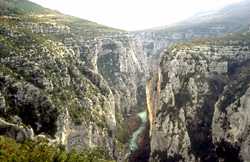
Tons of mangled cars piled up at the bottom of the Grand Canyon de Verdon in Provence are sombre evidence of France's high suicide rate. But on a brighter note, engineers now clearing the accumulated wreckage of 100 years are uncovering a veritable auto museum.
The Parc Régional du Verdon is a lush green landscape of deep canyons, thick vegetation and freshwater lakes. Located 90 km northeast of Aix-en-Provence in France's south-eastern Var district, the "Grand Canyon of Verdon" attracts one million nature-loving visitors each year. Unfortunately, some of them don't return. For decades, cars driven off the cliffs, some accidentally but many intentionally, have been piling up at the foot of the canyon.
It's a graveyard of old automobiles, some of them dating back to the 1930s. No one has bothered to it clean up -- until now. After two years of fund-raising, regional authorities recently completed the first two-week stage of a massive clean-up operation, lifting as much as 20 tonnes of debris out of the canyons.
Reason #1 Why you should drive slower in France ...
Extra Info:
Although it's much smaller than Arizona's Grand Canyon, the Gorges du Verdon is deep, compact, wild and beautiful. From Castellane to the village of Rougons, the Verdon river flows clear and swift, and the road follows along the banks. At Rougons, by the Point Sublime, the river plunges into the narrow rock walls, and there's no escape until it comes out the western end before flowing into Lac de Ste Croix.
Transportation
There isn't much in the way of public transportation in this area. The nearest train station is at Les Arcs (station Draguignan-Les Arcs). There are buses from Les Arcs to Draguignan and Aups.
History
The canyon was formed in the Quaternary Era, as a result of earth movements while the Alpes were "growing" upwards and from erosion of the Jurassic limestone by the Verdon river.
Through the 19th century, the deepest gorges were thought to be impenetrable. Only a few local woodcutters went down into the gorges on ropes, looking for box wood (buis) stumps that they used for making boules.
The canyon remained unexplored until the 20th century. Armand Janet attempted a canoe exploration in 1896, but gave up because of the violent currents. In August of 1905, the speleologist Edouard Alfred Martel did the first complete exploration of the gorges on a 3-day expedition. Part of the Martel trail is still used, between Point Sublime to La Maline.



No comments:
Post a Comment